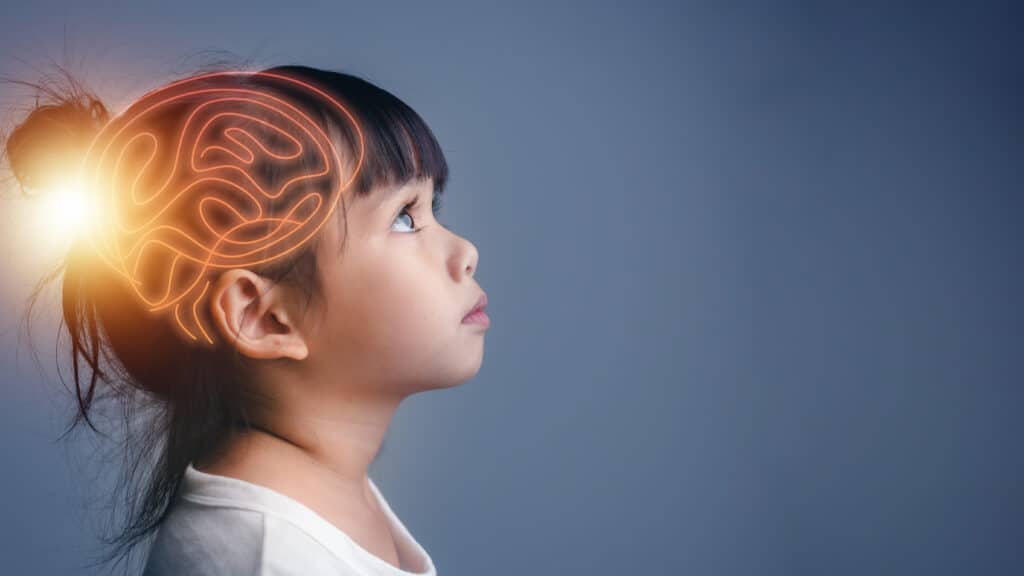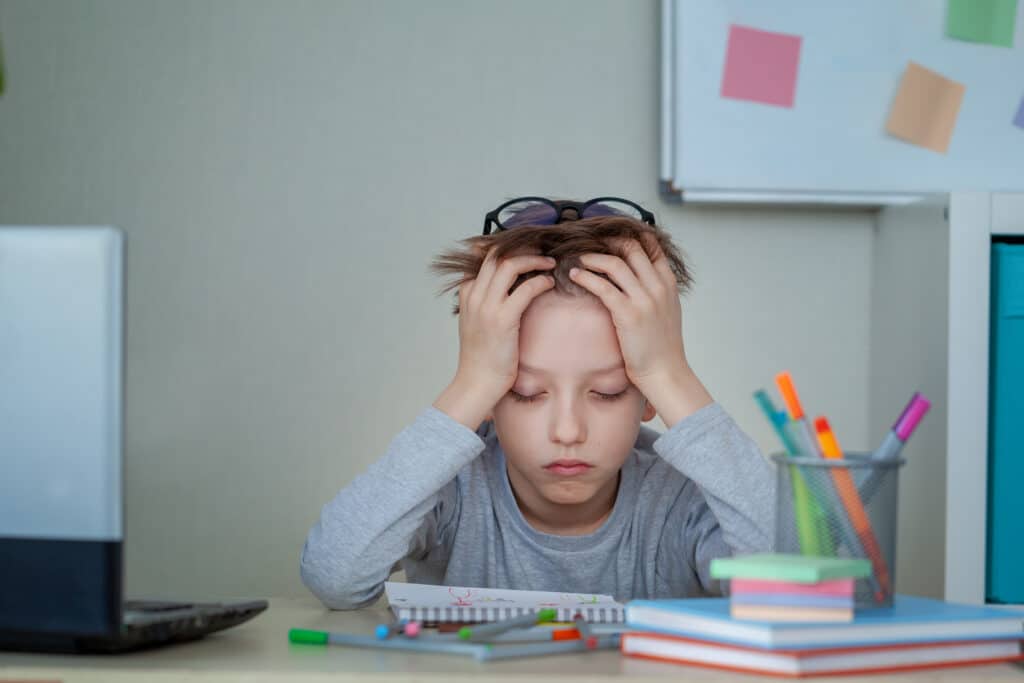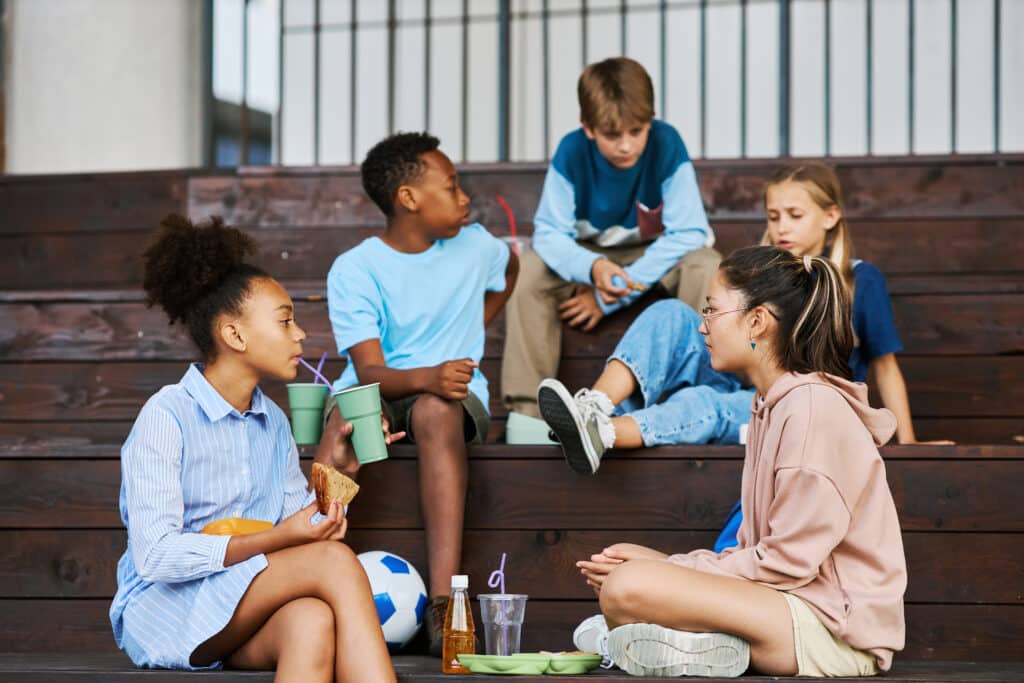What causes anger issues in a child? Understanding the underlying factors behind children’s anger problems is essential in addressing and resolving these challenging issues. Anger is a natural human emotion, but when it becomes excessive, uncontrollable, or disruptive, it can significantly impact a child’s behavior, well-being, and relationships. While every child’s experience is unique, common factors contribute to the development of anger issues. This article explores the importance of unraveling the causes of anger issues in children and emphasizes the significance of finding practical solutions that promote healthy emotional development.
How to recognize anger issues in children
When children become angry, they can put up an incredible show, displaying a range of behaviors and emotions that vividly express their displeasure. For example, a child’s face may turn red, their brows furrowed, and their eyes filled with intensity. Their expressions can be so powerful that it becomes evident how strongly they feel about the situation.
1. Symptoms of Anger in Kids
Kids may flop down, throw themselves on the bed, or slam doors with great force when angry. In some cases, children might resort to hurtful words like “I hate you!” or “It’s not fair!” to express their deep dissatisfaction and to gain attention and validation for their feelings.
Although parents might view their children’s angry outbursts and tantrums as being too theatrical for a given situation and sometimes getting angry themselves, this coping method is often not premeditated in children. It serves as a physical release and a sign that a lot of tension is building up. As adults, we were taught through punishments, social interactions, or positive modeling that these manifestations are not acceptable as effective ways to externalize feelings, so we developed coping strategies. Unfortunately, for children, emotional regulation is not a button that can be switched on and off. Emotional intelligence is earned when children learn to control impulses while exposed to frustrating elements and situations.
2. Understanding the Distinction: Anger vs. Aggression in Children
The conceptual difference between anger and aggression lies in their nature and expression. Anger is an emotional state characterized by frustration, displeasure, or irritation in response to a perceived threat or injustice. Although it can manifest in upsetting reactions like raising voice, refusing to follow instructions, or withdrawing from interactions, it is a normal and natural emotion experienced by individuals of all ages regardless of their inherent coping mechanisms. A study in the Social Psychological and Personality Science journal challenges the perception of anger as purely negative by associating it with internal motivation. The results add to the recent belief that anger makes people move closer to their goals, motivates them to address injustice, and drives them to become better people. On the other hand, aggression involves behavior that intends to cause harm, either physically or verbally, to others or oneself. The difference is significant to notice because it gives parents an insight into the intensity of emotions a child feels. Suppose the feeling of distress gets validated when the first sensations appear in the body. In that case, the child may get superior self-control and anger management skills than when their emotions are dismissed. Start with, “I see that you are angry now! Let’s paint a picture of what got us to this point” Next time you see arms flailing, pointing fingers, or even crossed arms in defiance. It doesn’t always come naturally, but it’s better for your relationship and your child’s emotional intelligence. A child who is out of control is a child asking for help.
👉 Tired of backtalk from your child? Learn how to put an end to it! Explore our article for effective strategies to improve communication and discipline. Click here to find out how to restore harmony in your home.
Exploring the Different Factors that Trigger Anger: What causes anger issues in a child
Many questions were raised about anger and the susceptibility to aggressive responses to upsetting stimuli. Is anger genetic? Are anger issues more related to the environment? Is aggressiveness a learned behavior?
1. Biological Causes of Anger in Children
An interesting study conducted by researchers at Pitsburg University discovered that genes play a significant role in how anger is externalized. It concerns the serotonin levels being rushed down our bodies to calm us down when things get steamed up. Hence, serotonin is a hormone that contributes to emotional regulation. Researchers found a link between certain behaviors and a specific gene related to serotonin receptors. This alteration is passed down to offspring, showing that genetic factors cause crankiness.
Brain Development
Other things to consider when analyzing irritability in children are developmental stages and brain architecture. What irritates a child can be different than what gets us all worked up as adults. The human brain grows gradually, starting with the cerebellum at the back and then moving to the midbrain, which handles emotions.

The last part to fully develop is the frontal cortex, which is responsible for essential skills like making good decisions and controlling impulses. It takes longer for this part of the brain to mature, making things challenging. For example, a toddler’s temper tantrums are caused by this immature development of the brain’s prefrontal cortex, the emotional regulation center. A teenager’s anger adds hormonal imbalances to the mixture.
Anger and aggression in children are raw expressions from the brain’s construction site and are part of healthy development. Although genes and biology play their role, the responses we model as adults can enhance or inhibit our children’s regulation skills.
2. Environmental Causes of Anger in Children
Environmental causes play a significant role in developing anger issues in children. Various factors within a child’s surroundings can contribute to the manifestation and escalation of irritability. Here are the most common causes:
Family Dynamics
This takes us back to learned behaviors. It’s the “monkey see, and monkey do” effect of child rearing. Children who witness harsh expressions of anger might pick them up and integrate them as coping methods. Different parenting styles might make things even more confusing.
Let’s take a fictional family. A hot-tempered man, Dad often expresses his annoyance through loud outbursts and aggressive behavior. On the other hand, Mom is a gentle and patient woman who believes in calm discussions and finding peaceful solutions. Add a pair of permissive, easy-going grandparents, and you probably get a child with poor self-regulation skills. Family members differing approaches to anger management can create confusion within the household, especially for kids. They constantly search for role models and are directly impacted by their caregivers’ responses.
Traumatic Experiences
Trauma is not always visible. Some of us might be impacted by events like losing a loved one or being subjected to situations with high physical or emotional intensity, like abuse or domestic violence. However, trauma in kids might be set off by less apparent elements.
Their reasoning and verbalization skills, yet immature, prevent them from getting access to practical coping skills. The visible irritation in young children is usually a sign of intense frustration. It may come from situations as simple as forgetting their comforting object at home while taking a long trip or not having the chance to say goodbye to parents through a specific ritual when they’re dropped off at kindergarten. For older children, traumatic events might mean struggling with peer acceptance or bullying.
It’s advised for parents to address anger issues from the first sign by using empathy and active listening. Dismissing or minimizing the child’s feelings might make them feel unsupported and unheard and shape their perception toward unhealthy and ineffective anger management and coping skills.
Stressful Home or School Environment
Chaotic environments contribute to the onset of anger issues. The reasons are obvious. Some family environments are loud and stressful. Constant conflict, arguments, and disorganization can create a tense and stressful atmosphere, where irritability can easily escalate and become a dominant emotion. For example, if a child grows up witnessing frequent yelling matches between their parents or experiencing unstable living conditions, they may internalize and learn maladaptive ways of expressing and coping with anger.

Schools can also be challenging environments that contribute to anger issues. Academic pressure, such as high expectations, heavy workloads, and the fear of failure, can create significant stress. Peer problems, including bullying, social exclusion, or conflicts with classmates, can also fuel frustration in children.
Modeling Behavior
Parents are not robots, and that’s what makes their role so special. Unlike machines, parents have the ability to love unconditionally, provide comforting hugs, and offer emotional support to their children. Being human also means experiencing various emotions and facing unexpected challenges that can sometimes leave parents feeling overwhelmed, heartbroken, stressed, and worried.
There are moments when our emotions get the best of us, leading to anger, raised voices, or even punishments that we later regret. Yet, if we don’t return to discuss our actions with our children or apologize for bad decisions or mistakes, we’re depriving them of good opportunities to learn how to self-regulate and how to nurture positive relationships with others.
Social Influences
Parenting is not an isolated journey. Close family, teachers and peers at school, friends, and the extended community; all contribute to shaping our children’s individuality. There are many parents who claim that they strive to create a peaceful home environment, but their kids are still under a lot of stress, always displaying angry behavior. It is worth mentioning that, especially in adolescence, friends and peers can have a profound influence, sometimes leading to negative behaviors or pressure that may contradict the values and principles taught at home.

As social interactions are undeniably important for a child’s development, we can’t keep them forever under our wing. What we can do is to foster open lines of communication with our children and actively engage in their social circles. By doing so, we can gain insight into the external factors that may be contributing to their stress, anger, or aggression.
Media Influence
The media plays a significant role in shaping children’s development, including their attitudes, behaviors, and emotional responses. In the context of anger and aggression, media exposure can have both direct and indirect influences on children.
Directly, media content such as violent movies, TV shows, video games, and online platforms that depict aggression can desensitize children to violent behavior and normalize aggression as a means of problem-solving or conflict resolution. This can contribute to increased aggressive thoughts, feelings, and behaviors among children. Indirectly, media can influence children’s perceptions of social norms and acceptable behavior. For instance, when they repeatedly see aggressive or angry characters portrayed as powerful, successful, or heroic, children may internalize the idea that aggression is a valid and effective way to assert control or achieve goals. This distorted view can affect their own behaviors and lead to difficulties in managing irritability and resolving conflicts peacefully.
Furthermore, exposure to sensationalized news or negative online content can contribute to heightened stress, anxiety, and frustration among children. Continuous exposure to such content can create a perception of a hostile world, leading to heightened levels of anger and aggression.
Effective Strategies for Dealing with Childhood Anger
Help your child understand their emotions and provide them with tools to regulate their anger. Deep breathing exercises, counting to ten, or engaging in calming activities like drawing or listening to music can help them calm down and gain control over their emotions.
Create a supportive family environment

The turning point for healthy emotional development lies in how parents respond to anger outbursts. When parents respond negatively to their child’s anger, they unintentionally activate the fight or flight response in their child’s body. This automatic physiological response doesn’t promote effective reasoning and problem-solving skills. The child feels attacked and shuts down.
Parents should focus on guiding children to identify the source of their displeasure, exploring possible solutions, and considering the consequences of different actions.
When it comes to outside influence, we must strike a delicate balance between allowing our children to explore their social connections and ensuring that they are surrounded by positive influences. Providing a stable family life, encouraging healthy friendships, improving their self-esteem through positive reinforcement, and staying involved in their school and community can provide opportunities to guide and shape our kids’ social interactions.
Teach and model better coping skills and impulse control
Bring more awareness about emotional health and include open discussions in your family routines. Help children identify and label their emotions, which is the first step in developing impulse control.
When your child is acting out, try to introduce age-appropriate mindfulness exercises, such as deep breathing or focusing on the present moment. You can go as far as joining a parent-child yoga class or practicing guided meditations, or you can keep it simple and budget-friendly by teaching your child to pause and think. “I see that you are angry now. We wouldn’t want you to throw flames like a dragon or laser beams. Let’s both take 10 deep breaths and see what happens.”
For at-home behavioral therapy, engage children in activities that promote delayed gratification, such as puzzles, projects, or games with rules. Gradually increase the waiting time for rewards to help them develop patience and impulse control. This is crucial for younger children in particular because struggling with a lack of patience is a common early childhood issue.
Encouraging alternative activities such as sports, outdoor activities, or engaging in positive social interactions can provide children with constructive outlets for their energy and emotions, reducing the likelihood of resorting to aggression as a response.
Recognizing Concerning Signs: When Should Parents Be Worried About Their Child’s Anger?
If a child consistently struggles with irritability and impulse control, it is important for parents to recognize that there may be underlying issues contributing to these challenges. Certain signs, such as persistent behavioral problems, difficulties with attention and hyperactivity, or characteristics associated with the autism spectrum, can indicate the need for further evaluation and support.
For instance, children with Attention Deficit Hyperactivity Disorder (ADHD) often exhibit impulsive behaviors, including difficulty regulating their anger. They may struggle with controlling their impulses, have trouble focusing, and display high energy levels. Similarly, behavior problems that persist over time and across various settings may suggest the presence of underlying issues requiring professional attention.
👉 Is your child struggling with self-harming behavior? Discover why kids hit themselves and gain valuable techniques to put an end to it. Click here to read our article and provide the support your child needs.
When faced with ongoing difficulties with irritability and impulse control, seeking professional help from a mental health professional becomes crucial. These professionals, such as child psychologists or behavioral specialists, can provide specialized assessments, tailored strategies, and targeted interventions to address the specific child’s needs.
It is important to mention that seeking professional help is not a sign of weakness or failure as a parent. Rather, it demonstrates a commitment to the well-being of the child and a proactive approach to addressing their needs. Early intervention and appropriate support can have a significant positive impact on the child’s emotional regulation and overall development.
Conclusion
While children’s anger issues can be challenging for parents or caregivers to handle, they are a natural part of their emotional development. It is necessary to provide a safe and supportive environment for children to express their anger while teaching them appropriate ways to manage and regulate their emotions. This can be achieved through open communication, teaching problem-solving skills, and guiding them towards healthy coping mechanisms like taking deep breaths, using calming techniques, recognizing feelings in others, or expressing their own feelings through art or writing.
Discover effective parenting strategies and gain science-based insights at our upcoming online parenting events. Join us to our masterclass “How to Calm You And Your Child During Tantrums, Hitting or Yelling Hurtful Things: 4 Steps” and let’s delve into topics such as managing irritability in children, fostering emotional intelligence, and promoting healthy communication. Our expert speakers will provide practical tips and evidence-based approaches to support you on your parenting journey. Don’t forget to engage with our AI chatbot, Sophie, who is available 24/7 to provide personalized guidance and answer your parenting questions. Register now and empower yourself with the knowledge and tools to create a positive and nurturing environment for your children.
References
Aarts, H., Ruys, K. I., Veling, H., Renes, R. A., & Geertjes, S. (2010). The Art of Anger. Psychological Science. https://doi.org/10.1177/0956797610384152
Association for Psychological Science. (2010). Anger makes people want things more. https://www.psychologicalscience.org/news/releases/anger-makes-people-want-things-more.html
Bauer, A. M., Quas, J. A., & Boyce, W. T. (2002). Associations between physiological reactivity and children’s behavior: Advantages of a multisystem approach. Journal of Developmental and Behavioral Pediatrics, 23(2), 102–113. https://doi.org/10.1097/00004703-200204000-00007
Baughman, N., Prescott, S. L., & Rooney, R. (2020). The Prevention of Anxiety and Depression in Early Childhood. Frontiers in Psychology, 11. https://doi.org/10.3389/fpsyg.2020.517896
Buss, K. A., & Kiel, E. J. (2004). Comparison of Sadness, Anger, and Fear Facial Expressions When Toddlers Look at Their Mothers. Child Development, 75(6), 1761-1773. https://doi.org/10.1111/j.1467-8624.2004.00815.x
Fakra, E., Hyde, L. W., Gorka, A., Fisher, P. M., Muñoz, K. E., Kimak, M., Halder, I., Ferrell, R. E., Manuck, S. B., & Hariri, A. R. (2009). Effects of HTR1A C(-1019)G on Amygdala Reactivity & Trait Anxiety. Archives of general psychiatry, 66(1), 33. https://doi.org/10.1001/archpsyc.66.1.33
Lewis, M. (2010). The Development of Anger. In: Potegal, M., Stemmler, G., Spielberger, C. (eds) International Handbook of Anger. Springer, New York, NY. https://doi.org/10.1007/978-0-387-89676-2_11
Smith, K. E., & Pollak, S. D. (2021). Social relationships and children’s perceptions of adversity. Child Development Perspectives, 15(4), 228-234. https://doi.org/10.1111/cdep.12427
Tierney, A. L. (2009). Brain Development and the Role of Experience in the Early Years. Zero to three, 30(2), 9. https://www.ncbi.nlm.nih.gov/pmc/articles/PMC3722610/
Veling, H., Ruys, K. I., & Aarts, H. (2011). Anger as a Hidden Motivator. Social Psychological and Personality Science. https://doi.org/10.1177/1948550611425425
Wang, X., Trivedi, R., Treiber, F., & Schnieder, H. (2005). Genetic and Environmental Influences on Anger Expression, John Henryism, and Stressful Life Events: The Georgia Cardiovascular Twin Study. Psychosomatic Medicine 67(1):p 16-23, https://doi.org/10.1097/01.psy.0000146331.10104.d4











